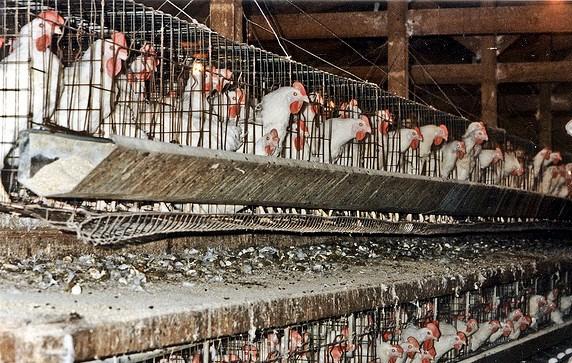Nine more H5 avian influenza outbreaks that were reported on Iowa poultry farms in the past 2 days, combined with previous outbreaks, will mean the loss of about a quarter of the state's 60 million layer hens, state officials said today.
In addition, Minnesota officials today announced three more turkey-farm outbreaks and reported finding the virus in a dead hawk, the first known wild-bird infection in the state that has by far the most poultry outbreaks.
Six outbreaks in one Iowa county
The Iowa Department of Agriculture and Land Stewardship (IDALS) reported four outbreaks late yesterday and added five more today. Six of them are in Buena Vista County in the northwestern part of the state.
Initial testing pointed to a highly pathogenic (HP) H5 virus, but there was little doubt that it would be confirmed as H5N2. At an afternoon press conference, Iowa Agriculture Secretary Bill Northey said birds on all the farms are showing clinical signs, "so we highly suspect they'll come back with N2" confirmed.
One of the Buena Vista County outbreaks reported today is on a farm with 5.5 million layer hens, the IDA reported. The virus also hit two Buena Vista turkey farms, with bird counts not yet available; a Sioux County farm with 84,000 layer hens; and a Clay County layer operation, with no bird count available yet.
The four outbreaks reported yesterday included three on Buena Vista County farms: one with 50,000 turkeys, one with an unknown number of turkeys, and one with 63,000 layers. Also hit was a farm with 19,000 breeder chickens in Kossuth County, in north-central Iowa.
Northey said 17 farms in seven Iowa counties have been affected so far, compared with just three farms a week ago.
Concerning the losses, Northey said, "I believe we're somewhere north of 15 million layers right now. That would be about one fourth of Iowa's layers. . . . That's going to be 5 to 6% of layers in the US. Once you start getting those kinds of number you can start having an impact."
He added that Iowa has lost some markets overseas, which keeps some of Iowa's production at home and could counterbalance to some degree any upward pressure on egg prices, "but we'll probably still see some impact."
In response, to questions, Northey said no H5N2-infected migratory birds have been found in Iowa and noted that the virus's pathway into poultry barns remains a mystery. He said some farms that are close to outbreak sites get hit with the virus but others don't.
"There could be something that flew over and left something that somebody walks through and takes into the barn," he said. "We all wish we had all the answers as to exactly how this is moving."
He urged reporters who cover the story, along with everyone else, to take careful biosecurity measures: "Maybe do [report on or go to] a negative site before you do a positive site," to avoid spreading the virus.
Northey also announced that the state has set up a hotline to provide information about avian flu: 800-447-1985.
Infected hawk in Minnesota
In Minnesota, the virus was found in a female Cooper's hawk that died when it flew into a homeowner's deck in Yellow Medicine County on Apr 14, the state Department of Natural Resources (DNR) reported in a press release. The county, in southwestern Minnesota, has not had any H5N2 outbreaks but is sandwiched between two other counties (Lac Qui Parle and Lyon) that have.
"This bird tells us our surveillance is working, but it unfortunately doesn't provide many other clues about transmission of the virus," Lou Cornicelli, DNR wildlife research manager, said in the release.
Wild waterfowl are known to carry and potentially spread H5N2 without getting sick, the DNR noted. The virus has also been found in captive raptors in Washington, Idaho, Montana, and Missouri, according to the US Department of Agriculture (USDA).
Cornicelli said the hawk discovery does not indicate the virus in wild birds is the direct cause of Minnesota's current poultry infections. The DNR is not aware of any recent raptor die-offs.
Cooper's hawks are common, crow-sized raptors that inhabit Minnesota's open woodlands, the DNR said. Unlike some other raptors, they don't prey on waterfowl or scavenge but primarily kill smaller birds. Cornicelli said the hawks likely get the virus from something they eat.
The USDA reported in January that a Cooper's hawk in Washington state tested positive for the virus, the DNR noted.
As previously reported, the DNR is using a three-pronged strategy to look for HP avian flu viruses in wild birds: testing waterfowl fecal samples from across the state, asking hunters in four affected counties to submit wild turkeys for sampling, and collecting dead birds reported by the public.
The agency said it has collected 29 dead birds of various species, of which 9 have tested negative and 20 results are pending. Results for 37 hunter-killed turkeys are also awaited, and more than 2,200 of 2,749 waterfowl fecal samples have tested negative, with the rest still pending.
Three Minnesota outbreaks
The three Minnesota outbreaks reported today involve two turkey farms in Stearns County in the central part of the state and one turkey farm in Otter Tail County, which is west-central, the Minnesota Department of Public Safety reported. They raise Stearns County's outbreak count to 14 and Otter Tail's to 3.
The Stearns County farms have 14,800 and 20,500 turkeys, while the number for the Otter Tail farm has not yet been determined.
The three events increase Minnesota's overall outbreak count to 70, with 19 counties affected. All but a few have involved turkey farms. State officials put the number of birds at 3.94 million, which does not include sites for which bird counts are still awaited.
See also:
Apr 30 IDA statement
Apr 29 IDA statement
Minnesota DNR statement on infected hawk
Apr 30 Minnesota DPS statement





















